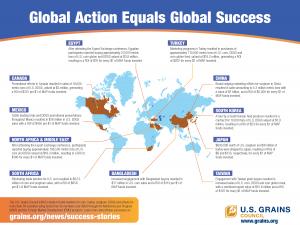Around the world and around the clock, the U.S. Grains Council’s (USGC) staff and consultants are working on behalf of the organization’s members to help U.S. agricultural exports reach new levels of demand and growth. A selection of success stories on the Council’s website chronicles the Council’s push to find new buyers for a bountiful harvest in up-and-coming markets as well as maintain demand with our long-term trading partners.
The stories cover the breadth of USGC activities in areas including technical assistance, trade servicing and trade policy as the Council promotes U.S. barley, corn, sorghum and related products including distiller’s dried grains with solubles (DDGS) and ethanol. The stories span the Council’s work in more than 50 countries and the European Union through the Council’s 10 overseas offices and 30 in-country representatives.
Events like Export Exchange, conducted a year ago this month, bring together teams of representatives from major feed grain importing countries with U.S. suppliers. More than 200 international buyers and end-users of coarse grains and co-products from more than 35 countries participated along with 180 U.S. industry members.
At the conclusion of the conference, the Council surveyed participants, who reported the amount of commodities they purchased or were negotiating. For example, a nine-person team from Morocco, Tunisia, Lebanon and Jordan reported sales of 106,500 tons of corn and DDGS purchases valued at $18.3 million, a return of investment equal to $180 for every $1 of MAP funds invested in this one delegation.
The positive impacts of events like Export Exchange continue far after the event includes. The Council’s engagement in Bangladesh, which included bringing buyers to the 2014 Export Exchange, set the groundwork for the country’s first shipment of U.S. corn. In all, Bangladesh imported 105,900 metric tons (4.17 million bushels) of U.S. corn in 2016, valued at $17 million, a return on investment of $113 for every $1 of MAP funds invested.
The Council continues to find new opportunities for U.S. agricultural exports, even in the largest and most loyal markets. In Japan, the Council is promoting high beta-glucan barley and food-grade sorghum for products targeted to health conscious Japanese consumers. Combined, Japan imported $8 million of barley and $600,000 of U.S. sorghum in 2016 for a premium price, offering an additional, value-added market for U.S. producers.
These efforts would not be possible without the steadfast support of our members as well as the U.S. Department of Agriculture’s Foreign Agricultural Service through the Market Access Program (MAP) and Foreign Market Development (FMD) programs as authorized in the 2014 Farm Bill. This collection of success stories specifically details the return on investment for MAP and FMD dollars invested through these programs.
Learn more about these success stories in the infographic attached to this story and even more at http://grains.org/news/success-stories.


